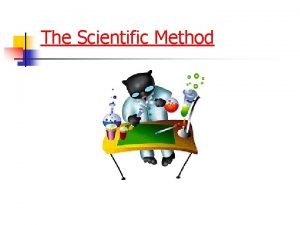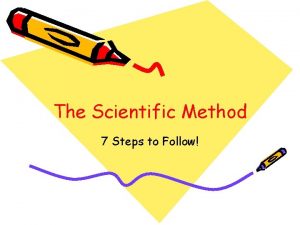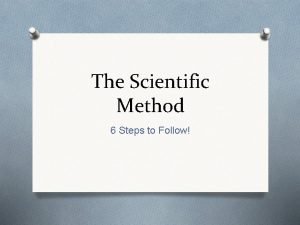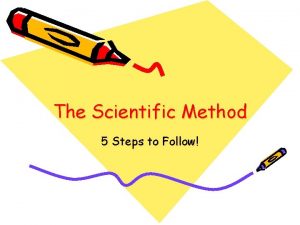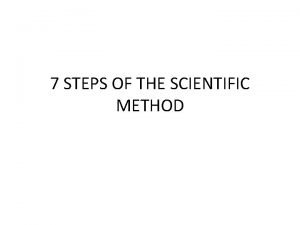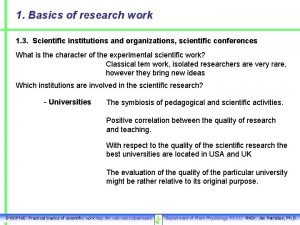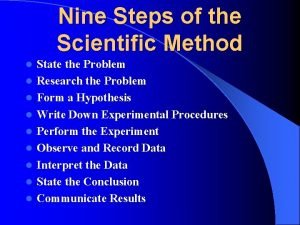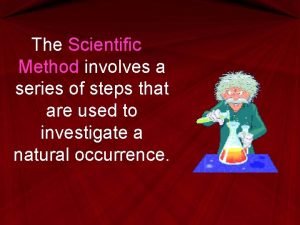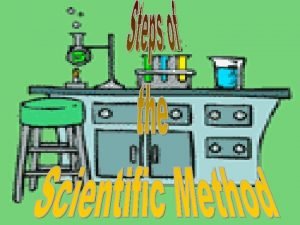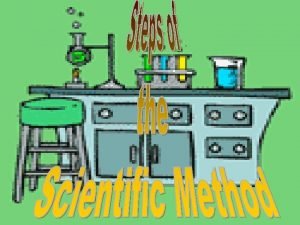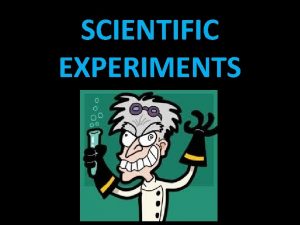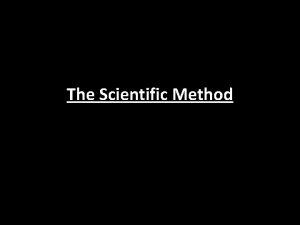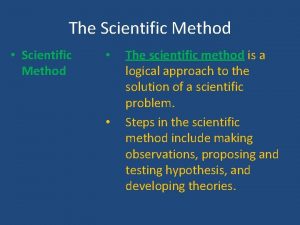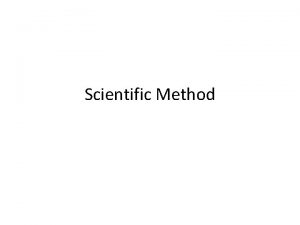The Scientific Method 6 Steps to Follow The




















- Slides: 20

The Scientific Method 6 Steps to Follow!

The Scientific Method is a series of steps scientists follow to answer a question or solve a problem. There are 6 main steps.

Step 1: Ask a Question Scientists ask questions based on observations from their surroundings § An observation is information from your 5 senses. § An observation is a fact. An observation is different than an inference. An inference is something you think, based on an observation and what you already know.

Step 1: Ask a Question Scientists ask questions based on observations from their surroundings § The question must be about something that can be tested by an investigation. § The question must be about something that you can measure. § This kind of question is called a “testable question. ”

Step 1: Ask a Question For example, I think Batman is the best superhero. My brother thinks Superman is the best superhero. Who is right? Is that a testable question? Can you find the answer by measuring?

Step 1: Ask a Question Are these testable questions? (Can we measure the results? ) Can Batman or Superman carry more weight? Can Batman or Superman run a mile faster? Can Batman or Superman fly through the air for a longer period of time? Is Batman or Superman’s cape better? Can Batman or Superman jump higher?

Step 1: Ask a Question Is this a question that can be answered with the Scientific Method? What kind of insulation keeps the heat out of the house the best? n a n g h i c s u e d m an ow c h u e o r Y su. a e e s m u o o h t e t n h t e f m i o exper kept out is heat Yes!

Step 1: Ask a Question Is this a question that can be answered with the Scientific Method? What brand of gum tastes best? of r e t t a m sa i r e h w g s u n o a r h e t h n T ove r p e b t nno ut a o c d d n i n f a uld o c u opinion o Y ers. t m n u e s n m i o r c ost m an expe m u g of d t. s n a e r b b s i h t c i wh wha t o n t u , b t s e b e k i l No!

Step 1: Ask a Question Is this a question that can be answered with the Scientific Method? What is the best time to plant tomatoes in Chandler? be n a c r e. w t s n n e a m i er The p x e an h g u o r h t n e v ! s e Y pro

Step 2: Research Do background research about the topic. (Find out what other scientists have already learned. )

Step 3: Form a Hypothesis Take an educated guess about what you think the answer is to your question.

Step 4: Test your hypothesis § Plan the experiment Set up an experiment to test your question. Your experiment tests whether your hypothesis is supported or not.

Step 4: Test your hypothesis § Plan the experiment It is important for your experiment to be a fair test. A fair test changes only one factor (variable) at a time. All other conditions stay the same.

Step 4: Test your hypothesis § Plan the experiment § Make a list of materials needed What type of supplies and equipment will you need to complete your experiment?

Step 4: Test your hypothesis § Plan the experiment § Make a list of materials needed § Conduct the experiment Carefully record your data Organize your data using a graph or chart

Step 4: Test your hypothesis § Plan the experiment § Make a list of materials needed § Conduct the experiment Repeat your experiment several times to make sure that the first results weren't just an accident.

Step 5: Analyze Your Results Look at your results. Decide what the answer to your question is and ask: § Was my hypothesis supported or not supported by the results? § Do I need to conduct the experiment again?

Step 6: Communicate Results § Record your results clearly so that others can understand them. § Include your data in a graph or chart.

Step 6: Communicate Results There are many ways to communicate your results.

The Scientific Method Do you remember the 6 steps to follow? 1. Ask a Question 2. Research 3. Form a Hypothesis 4. Test your Hypothesis 5. Analyze your Results 6. Communicate Results
 Follow you wherever you go
Follow you wherever you go Information gathered during an experiment
Information gathered during an experiment 7 steps of the scientific method
7 steps of the scientific method 7 steps of the scientific method
7 steps of the scientific method What are the 7 steps of the scientific method
What are the 7 steps of the scientific method 6 steps scientific method
6 steps scientific method 5 steps of scientific method
5 steps of scientific method Steps of scientific method
Steps of scientific method Scientific method steps
Scientific method steps Scientific method steps
Scientific method steps The 7 steps of the scientific method
The 7 steps of the scientific method What are the 7 steps in the scientific method?
What are the 7 steps in the scientific method? Steps of scientific method
Steps of scientific method Six steps to the scientific method
Six steps to the scientific method 9 steps in scientific method
9 steps in scientific method Scientific method steps
Scientific method steps Scientific method steps
Scientific method steps Scientific method steps
Scientific method steps Scientific method steps
Scientific method steps How is a scientific law different from a scientific theory?
How is a scientific law different from a scientific theory? Scientific experiment steps
Scientific experiment steps


